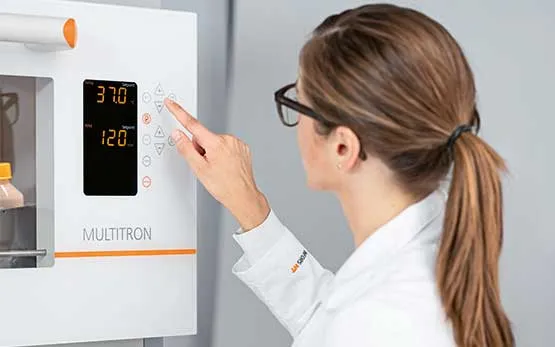Shaken stem cells exhibit far better, scalable growth than static stem cell cultures. There are two agitation options: either in a suitable incubation shaker or in an incubator with a specialized benchtop shaker compatible for use in the CO2 atmosphere. In order to successfully culture stem cells in a suspension or on microcarriers, the shaker or incubator needs gentle mixing, precise CO2 regulation, and active, hygienic humidity control. Sterility plays an important role as well.
Constant, homogeneous conditions
Maintaining optimum culture conditions throughout the entire bioprocess is a prerequisite for obtaining reproducible results from a stem cell culture. It follows that an incubation shaker that has been optimized for stem cell cultures allows operators to precisely control the CO2 feed and humidity. Reliable temperature uniformity is important as well. An appropriately gentle drive system ensures that shear-sensitive cell suspensions will have enough oxygen available to them.
Hygienic environment for stem cells
Contamination in stem cell experiments is time-consuming and costly. Stem cell shakers therefore offer specialized features that reduce the risk of contamination. Ideally, shakers should also be equipped with other hygienic features, such as an antimicrobial coating and UV radiation. Another point to consider when selecting an incubation shaker is the ability to clean the shaker quickly and thoroughly, and a means of collecting overflow liquids in the inner chamber.
Shaker for CO2 incubators
Stem cells can also be cultivated on a shaker in a CO2 incubator. The benchtop shaker must be designed for use in the acidic incubator atmosphere, as it may otherwise be susceptible to corrosion. The ability to control the shaker from outside of the incubator and to detect operating conditions from a distance are also major advantages. The shaker used must produce as little waste heat as possible in order to ensure uniform temperature distribution and thus optimum conditions for the cells in the incubator.
Screening for optimum media components
Media components such as growth factors play a very important role in culturing stem cells, as they regulate the behavior of the stem cells—in other words, they influence cell viability, proliferation and differentiation. This means that, in addition to adjusting process parameters, the behavior of cultured stem cells can also be controlled in vitro by modifying media composition. Shakers are frequently used for optimizing media, as many experiments can be run cost-effectively and in parallel.
Automation reduces the need for manual interventions
Modern shaker accessories can optimize stem cell culturing, making the process more user friendly. Integrating an automated feeding system increases biomass yield and/or productivity with no need for stopping the culturing process manually— all while allowing users to create feeding profiles for a given application. In addition, bioprocess software also gives operators the ability to monitor and control the operating parameters of the incubation shaker or incubator from any location. Users can, for instance, program the incubation time required for stem cells to adhere to the microcarrier before shaking begins.
Make your shaken stem cell culture a success

Minitron – Version for cell cultures
Compact incubation shaker for up to 18 L
- Two units can be stacked
- Small dimensions


